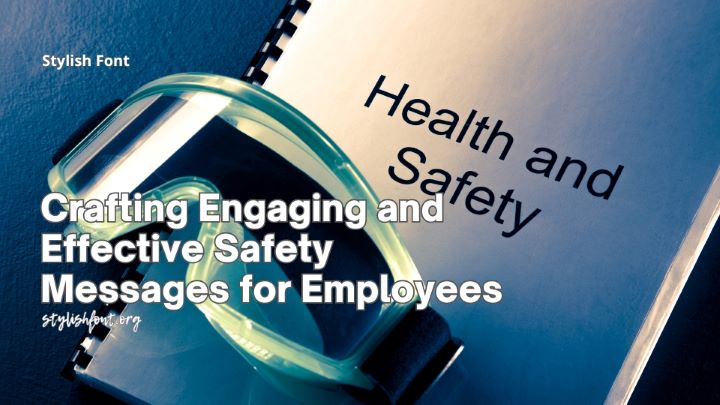Key Takeaways
- Utilizing daily safety messages can significantly improve workplace safety.
- Effective communication strategies can increase employee engagement with safety protocols.
- Real-world examples highlight the importance of consistent safety messaging.
Importance of Daily Safety Messages
Keeping employees informed about safety protocols is crucial to maintaining a secure workplace. Consistent safety messages serve as reminders and offer a way to highlight potential hazards before they occur. Therefore, having a safety tip of the day can be invaluable. According to a recent report from OSHA, workplaces that prioritize safety communication see a reduction in accidents and related costs. It underscores the significance of daily updates, emphasizing safety’s importance and creating a consistent narrative that integrates safety into the daily workflow.
Moreover, daily safety messages cultivate an atmosphere where safety is seen as a continuous, integral part of the workday, not just a one-time training session. Workers who get this regular training are more adept at internalizing safety protocols and are more proactive in identifying and reducing risks. The chance of mishaps is significantly decreased, and the general workplace culture is improved when safety is taken for granted.
Critical Elements of Effective Safety Messages
Effective safety messages should be clear, concise, and actionable. They should emphasize the message’s relevance to everyday tasks and foster a safety culture. Each element contributes to making the messages informative but also compelling and memorable for employees. Here are some critical elements:
- Specificity: Tailor messages to address particular tasks or hazards. For instance, if there is a specific machinery-related risk, the message should focus on the safe operation of that machine rather than general safety advice.
- Relevance: Ensure the message applies to the audience. If the message doesn’t relate to their daily tasks, employees will likely ignore it. Contextual examples help here, making the message more relatable and actionable.
- Actionability: Include precise actions employees can take. For example, a message about chemical safety should highlight specific steps employees must follow, like proper storage and handling procedures.
- Positivity: Frame messages in an encouraging manner to motivate employees. Positive framing can increase engagement and compliance. For instance, saying, “Wearing safety goggles keeps your eyes safe and ensures you can enjoy your hobbies outside of work,” is more uplifting than focusing on the potential negatives of not wearing them.
Ways to Deliver Safety Messages
The medium through which safety messages are delivered can significantly impact their effectiveness. Here are several ways to ensure your messages are heard and understood:
- Daily Briefings: Hold brief meetings to discuss safety topics at the start of each shift. This method is particularly effective as it sets the tone for the day and ensures that safety is the first thing on everyone’s mind as they start their tasks.
- Email Newsletters: Send out weekly summaries with safety tips and updates. This approach allows for detailed explanations and can be archived for future reference. It also reaches employees who might still need to attend the daily briefings.
- Visual Aids: Use posters, infographics, and digital displays to reinforce messages visually. Visual aids can capture attention quickly and are effective when placed in high-traffic areas where employees are likely to see them frequently.
- Interactive Training: Implement workshops that engage employees in safety practices. Interactive sessions can be more engaging than passive methods and help reinforce the message through hands-on experience. These sessions also allow employees to ask questions and clarify doubts, leading to better understanding and compliance.
Real-Life Examples of Successful Safety Messages
Here are some examples from companies that have successfully implemented effective safety communication strategies:
- Company A’s “Safety First” Campaign: This campaign included short, daily huddles where employees shared safety tips and experiences, creating a robust safety culture. Regular interaction kept safety top-of-mind and encouraged employees to contribute their ideas and experiences, fostering a community-driven approach to safety.
- Company B’s Visual Safety Boards: This company utilized digital screens in high-traffic areas to display rotating safety messages and updates, keeping safety top-of-mind for employees. This method ensured that safety reminders were always visible and could be easily updated to reflect new information or seasonal hazards.
The IHS Markit report provides more details on the impact of these strategies. These real-life examples highlight the importance of consistent and varied safety messaging, showing that when companies take innovative approaches to communication, they can significantly enhance their safety culture.
Common Mistakes to Avoid
When crafting safety messages, it is essential to avoid common pitfalls that can dilute their effectiveness. These include:
- Overloading Information: Too much information at once can overwhelm employees and reduce retention. Instead, focus on one key message at a time and break down complex information into manageable chunks.
- Irrelevant Content: It may be ignored if the message doesn’t connect with employees’ daily tasks. Ensure that every message clearly and directly impacts the tasks employees perform regularly. Tailoring messages to specific departments or job roles can increase their relevance and impact.
- Inconsistency: Sporadic or inconsistent messaging can create confusion and lessen the importance of safety. A consistent schedule for delivering safety messages helps reinforce their importance and ensures that employees come to expect and value them. Regular communication also allows for timely updates and reminders about changing safety protocols or emerging hazards.
Conclusion
Crafting and delivering effective safety messages is a cornerstone of fostering a safe and compliant workplace. Companies can significantly enhance their safety culture by understanding the importance of daily communication, employing key elements, and using varied delivery methods. Moreover, learning from successful examples and avoiding common mistakes will enable organizations to create a more engaged and safety-conscious workforce. A proactive approach to safety messaging prevents accidents and builds a culture where safety is a shared responsibility and a core value for everyone.





